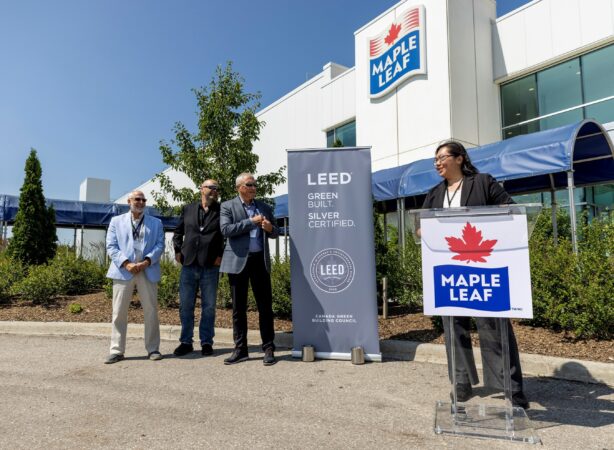
Maple Leaf Foods’ Hamilton facility receives green building certification
by CM staff

City of Hamilton provides $2.6 million grant to support sustainable building initiatives.

Photo: CNW Group/Maple Leaf Foods Inc.
MISSISSAUGA — Maple Leaf Foods was awarded the Leadership in Energy and Environmental Design (LEED) Silver certification by the Canada Green Building Council at its Heritage plant in Hamilton, Ontario. LEED is an international certification recognizing sustainability excellence and green building leadership.
Maple Leaf Foods received a $2.6 million grant from the City of Hamilton supporting the incorporation of many innovative and environmentally responsible design features which provide environmental and community benefits.
“We are really proud of what we have achieved at our Hamilton facility, and deeply appreciate the support we have received form the City of Hamilton,” said Randy Huffman, Maple Leaf Foods’ Chief Food Safety and Sustainability Officer. “It has been a journey to get here, and we look forward to leveraging our learnings as we continue to pursue our vision of being the most sustainable protein company on earth.”
Maple Leaf Foods officially opened the Hamilton plant in 2014, allowing it to bring together operations from five other smaller sites into this more efficient and automated facility. The plant spans approximately 500,000 square feet of floor space and employs over 900 team members who make a wide variety of hot dogs and deli meats – more than 500 products in total.
The Heritage facility has implemented several initiatives that have led to gradual reductions in Maple Leaf Foods’ environmental impact including, a national LED lighting retrofit program, equipment efficiency and optimization upgrades, ammonia heat recovery and wasted heat recovery systems, composting and recycling programs, control measures and closed-loop systems for water use, and improvements to storage, handling and employee training to reduce food waste.
As a result, Heritage has reduced its electricity by 72.9 per cent, natural gas intensity by 47.2 per cent, water intensity by 54.8 per cent all from a 2014 baseline, it’s solid waste intensity by 51 per cent from a 2015 baseline, and food waste intensity by 45.4 per cent since 2016.
Key building features that went into creating this ‘green’ facility include measures to encourage alternative transportation such as a bicycle storage area and the use of low emitting and fuel-efficient vehicles, optimizing energy performance, enhanced refrigeration management, water use reduction and using low-emitting materials, and maximizing open space to encourage interaction with the environment.